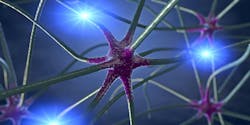An investigational gene therapy for a rare neurodegenerative disease that begins in early childhood, known as giant axonal neuropathy (GAN), was well tolerated and showed signs of therapeutic benefit in a clinical trial led by the National Institutes of Health (NIH).
Currently, there is no treatment for GAN and the disease is usually fatal by 30 years of age. Fourteen children with GAN, ages 6 to 14 years, were treated with gene transfer therapy at the NIH Clinical Center and then followed for about six years to assess safety. Results of the early-stage clinical trial appear in the New England Journal of Medicine.
The gene therapy uses a modified virus to deliver functional copies of the defective GAN gene to nerve cells in the body. It is one of the first times a gene therapy has been administered directly into the spinal fluid, allowing it to target the motor and sensory neurons affected in GAN. At some dose levels, the treatment appeared to slow the rate of motor function decline. The findings also suggest regeneration of sensory nerves may be possible in some patients. The trial results are an early indication that the therapy may have favorable safety and tolerability and could help people with the rapidly progressive disease.
Participants in this “first-in-human” trial, which began in 2015, received a single dose of the gene therapy, called scAAV9/JeT-GAN, through an injection into the fluid surrounding the spine. The first two patients received the lowest dose of the gene transfer, which was increased in subsequent patients. Four dose levels were tested over the course of the trial, which were estimated based on results from studies in animal models. Only one serious adverse event – a fever – was potentially linked to the gene therapy. The treatment resulted in 129 related adverse events of lesser seriousness, including headache, back pain, irregular heart rhythms, and inflammation in spinal fluid that was treated with corticosteroids. Two patients who were older and received the lowest-dose therapy died during the study period due to events related to their underlying disease.
In addition to safety, researchers also assessed motor function scores and tests of nerve function among the study participants. With increasing dose levels, they found the probability of any slowing of motor decline was 44%, 92%, 99%, and 90%, respectively. As GAN progresses, electrical measures of sensory nerves decline and eventually disappear. With gene therapy, 6 of 14 patients regained sensory nerve response after treatment—electrical measures increased, stopped declining, or became measurable after being absent.

